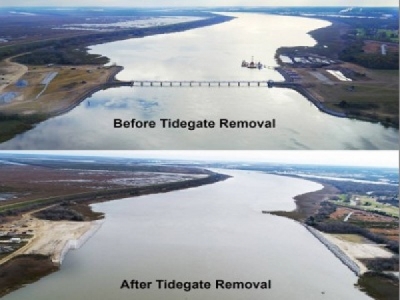
Posted on January 11, 2018
By Mary Landers, savannahnow.com
The Savannah River behind Hutchinson Island — known as the Back River — is looking like its old self again after the U.S. Army Corps of Engineers removed a more than 40-year-old concrete water-control structure called a tide gate.
“The Back River hasn’t looked this fly since bell bottoms were cool (the first time),” the corps tweeted Tuesday.
The $21.3 million demolition, completed by Miami-based DeMoya/Continental Joint Venture, is the latest mitigation feature completed in the nearly $1 billion Savannah Harbor Expansion Project.
“By removing the tide gates we restored the Back River to its natural state,” Spencer Davis, Project Manager for the SHEP, said. “This is the first part of the flow re-routing measures in the SHEP, designed to protect freshwater marshes in the Savannah National Wildlife Refuge from saltwater intrusion.”
The tide gates were installed in 1977 to trap water on the incoming tide, hold it in the Back River area, and allow the water to flush the front river navigational channel on the outgoing tide.
“This greatly reduced the amount of sediment that accumulated in the navigation channel and allowed sediments to be trapped in an adjacent sediment basin,” wrote Terry Stratton, a corps economist who studied the tide gate’s effects and reported his findings in the Proceedings of the 1999 Georgia Water Resources Conference. “Significant Operation and Maintenance funds were saved as distance to disposal areas was reduced, and dredges could operate uninterrupted by calling vessels.”
But its unintended consequences far outweighed those benefits. Increased salinity in the Back River, which is located almost entirely within the Savannah National Wildlife Refuge, converted rare fresh water marsh to brackish or salt marsh and devastated the striped bass population that spawned there.
“We all know what the tide gate did for sure,” said refuge manager Russ Webb. “It was a saltwater pump.”
The U.S. Fish & Wildlife Service has been ringing alarm bells about the tide gate since shortly after it was installed, with some success. In 1990 the tide gates were permanently opened. But it took another quarter century to remove the structure.
Savannah Riverkeeper Tonya Bonitatibus said she’s glad to see the corps abandon its old ways of “manhandling” rivers.
“We’re finding more and more man-made solutions need to be taken out because they’re doing more harm than good.
“We’re seeing a different way,” she said. “They’re re-establishing the way the river is supposed to flow.”
The refuge lands once hosted some 3,200 acres of rare tidal freshwater marsh, much of it far downriver. The remnants of rice fields right across from downtown Savannah are evidence this area was once fresh water. But incremental deepening from the river’s natural depth of 12-14 feet coupled with flow controls like the tide gate have salted up all but a quarter of those wetlands.
Webb is happy to see the tide gate gone.
“It helps the river mimic a more natural situation,” he said.
The refuge’s tidal freshwater wetlands are important not just for wildlife but for people, too.
“The Savannah refuge wetlands are crucial to absorb and hold fresh water longer,” Bonitatibus said, noting that they safeguard against increasing salinity in Savannah’s drinking water supply from both the river and the aquifer.
The tide gate’s removal returns the Back River to its natural width, which enhances the area for fish habitat. So does slower river flow that resulted from widening. Workers disposed of all of the 3,200 tons of concrete from the structure in the Back River, with some of that enhancing fish habitat, the corps stated. Still to come is a boat ramp planned for Hutchinson Island as part of harbor deepening mitigation. Located on government-owned land at the tide gate, the 2-lane concrete boat ramp facility will include a floating dock plus parking for 20 trailers and 12 vehicles.
The demolition came in on schedule and $900,000 under budget. Along with the concrete removal, workers removed more than 650,000 cubic yards of soil and placed approximately 130,000 tons of rock along the 3,000 feet of shoreline in both Georgia and South Carolina.
The harbor expansion project will deepen the harbor and entrance channel an additional 5 feet to enable newer and larger container ships to call on the Garden City terminal with greater ease, heavier cargoes and fewer tidal restraints than they currently experience. The project is funded jointly between the state of Georgia and the U.S. government.
Other significant harbor deepening mitigation features nearing completion include a dissolved oxygen injection system that aims to supply oxygen to the harbor in hotter months, a small reservoir near the Rice Hope subdivision that will provide freshwater storage for the city of Savannah, and the remaining features of work on the flow re-routing of the Savannah River adjacent to the refuge.
Removal and relocation of the Civil War ironclad the CSS Georgia and raising containment area dikes, wrapped up in the summer of 2017. Completion of the dissolved oxygen injection system and the reservoir is expected in the first half of 2018.
The current schedule estimates the harbor deepening will be complete in 2022.
Source: savannahnow





